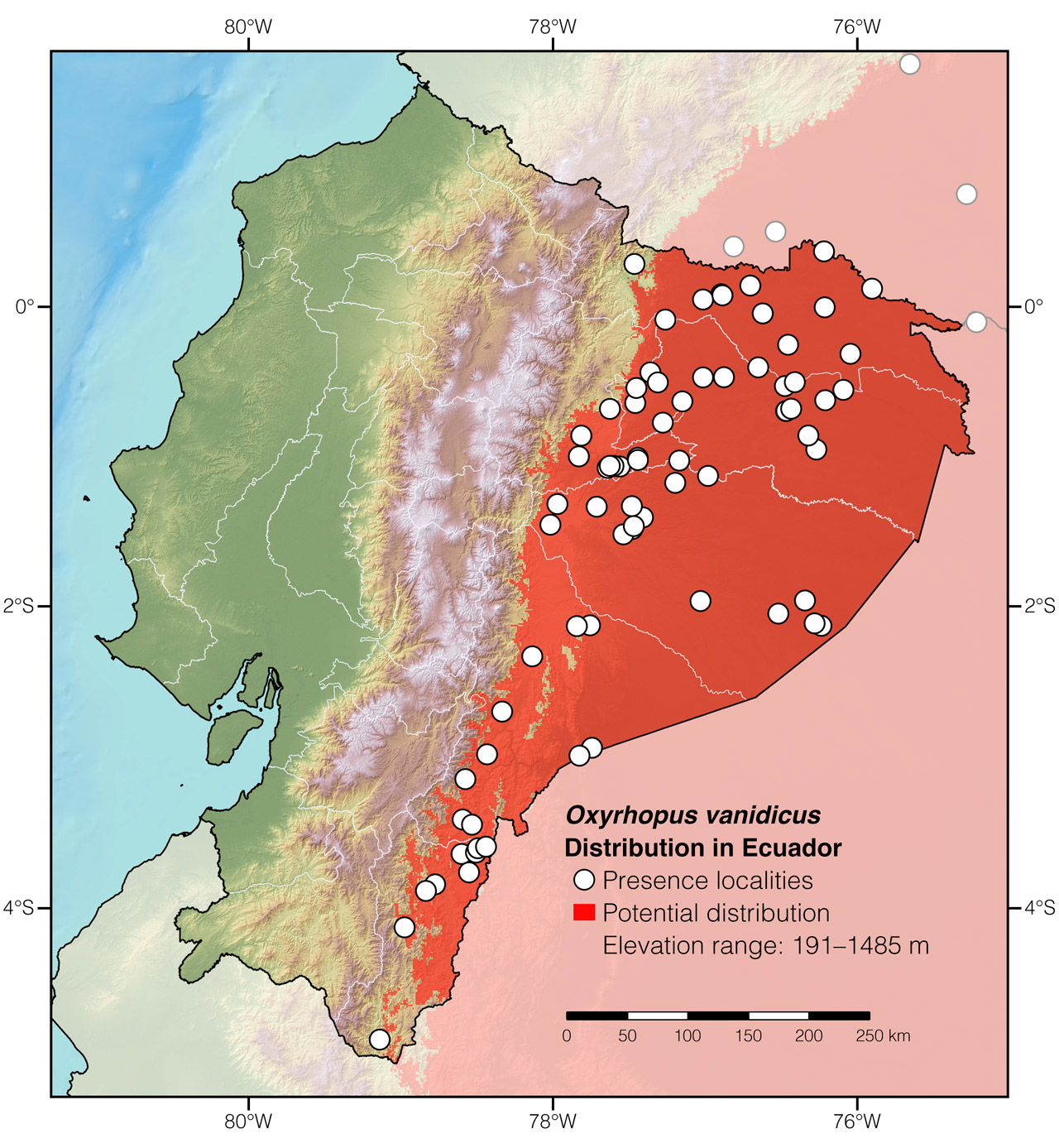Published September 6, 2020. Updated May 23, 2024. Open access. | Purchase book ❯ |
Impostor Flame-Snake (Oxyrhopus vanidicus)
Reptiles of Ecuador | Serpentes | Colubridae | Oxyrhopus vanidicus
English common names: Impostor Flame-Snake, Leticia Calico Snake.
Spanish common name: Falsa coral embustera.
Recognition: ♂♂ 86.1 cmMaximum distance from the snout to the tip of the tail. ♀♀ 101.8 cmMaximum distance from the snout to the tip of the tail.. Oxyrhopus vanidicus can be identified by having an orange band on the neck and a dorsal pattern consisting of wide black bands separated from each other by slim white bands and delimited by wider orange bands or patches.1–3 In some individuals, the light-colored bands may not be visible and the dorsum appears almost completely black (Fig. 1).1,2 Oxyrhopus vanidicus mimics the coloration of the coralsnake Micrurus ortoni (a case of BatesianA harmless species imitates the warning coloration of a venomous one. mimicry),2,4 from which it differs by having a whitish belly without defined rings.3 The melanistic individuals of O. vanidicus can be confused with adults of Clelia clelia, yet individuals of O. vanidicus have a more elongate head as well as a noticeably longer loreal scale.

Figure 1: Individuals of Oxyrhopus vanidicus from Ecuador: Napo Wildlife Center, Sucumbíos province (); Jatun Sacha Biological Reserve, Napo province ().
Natural history: Oxyrhopus vanidicus is a snake that inhabits old-growth5,6 rainforests as well as forest-edge situations,1 plantations, and open areas.4,7 Impostor Flame-Snakes are primarily nocturnal,6,8 but they can also be found active during the day.3 Although typically terrestrial,3,8,9 dwelling mostly on leaf-litter or on the forest floor,6 these snakes can also climb on vegetation up to 3.1 meters above ground level.4 Impostor Flame-Snakes are generalist foragers;9,10 their diet includes small rodents,1,3 lizards9 (such as Arthrosaura reticulata, Loxopholis parietalis, and Iphisa brunopereira),3 amphisbaenians,8 and birds.11 Members of this species are preyed upon by owls.4 These snakes are not aggressive; when disturbed, they flee into vegetation or vibrate the tail against the leaf-litter.6,8 The clutch size in this species consists of 12 eggs.3
Conservation: Least Concern Believed to be safe from extinction given current circumstances..12 Oxyrhopus vanidicus is listed in this category primarily on the basis of the species’ wide distribution spanning dozens of protected areas. In Ecuador, it is found in Yasuní National Park, Cuyabeno Wildlife Reserve, Sumaco National Park, and Podocarpus National Park. Ongoing human-related causes of mortality for members of this species include habitat loss, traffic, and direct killing. False coralsnakes in general are often mistaken with venomous snakes and therefore killed on sight.4 However, these causes will likely not lead the species to extinction in the near-term future.
Distribution: Oxyrhopus vanidicus is native to an area of approximately 183,386 km2 throughout the Amazon basin and adjacent foothills of the Andes in Colombia, Ecuador (Fig. 2), Perú, Brazil, and Venezuela.

Figure 2: Distribution of Oxyrhopus vanidicus in Ecuador.
Etymology: The name Oxyrhopus comes from the Greek words oxys (=quick) and rhops (=bush),13 and probably refers to the escape behavior of these snakes. The specific epithet vanidicus is a Latin word meaning “liar.” It refers to the fact that this species mimics the coloration of coralsnakes.
See it in the wild: Impostor Flame-Snakes can be seen at a rate of about once a month in forested areas throughout the Amazon basin in Ecuador. Prime locations for this species include Yasuní Scientific Station, Tiputini Biodiversity Station, and Jatun Sacha Biological Reserve, where the snakes are typically spotted on the forest floor along trails at night.
Authors: Amanda QuezadaaAffiliation: Tropical Herping (TH), Quito, Ecuador.,bAffiliation: Fundación Khamai, Reserva Arlequín, Ecoruta Paseo del Quinde km 56, Santa Rosa de Mindo, Pichincha 171202, Ecuador. and Alejandro ArteagabAffiliation: Fundación Khamai, Reserva Arlequín, Ecoruta Paseo del Quinde km 56, Santa Rosa de Mindo, Pichincha 171202, Ecuador.
Photographers: Jose VieiraaAffiliation: Tropical Herping (TH), Quito, Ecuador.,cAffiliation: ExSitu, Quito, Ecuador. and Amanda QuezadaaAffiliation: Tropical Herping (TH), Quito, Ecuador.,bAffiliation: Fundación Khamai, Reserva Arlequín, Ecoruta Paseo del Quinde km 56, Santa Rosa de Mindo, Pichincha 171202, Ecuador.
How to cite? Quezada A, Arteaga A (2024) Impostor Flame-Snake (Oxyrhopus vanidicus). In: Arteaga A, Bustamante L, Vieira J (Eds) Reptiles of Ecuador: Life in the middle of the world. Available from: www.reptilesofecuador.com. DOI: 10.47051/OWSK1023
Literature cited:
- Dixon JR, Soini P (1977) The reptiles of the upper Amazon Basin, Iquitos region, Peru. II. Crocodilians, turtles and snakes. Milwaukee Public Museum, Milwaukee, 91 pp.
- Lynch JD (2009) Snakes of the genus Oxyrhopus (Colubridae: Squamata) in Colombia: taxonomy and geographic variation. Papéis Avulsos Zoologia 49 : 319–337. DOI: 10.1590/s0031-10492009002500001
- Duellman WE (1978) The biology of an equatorial herpetofauna in Amazonian Ecuador. Publications of the Museum of Natural History, University of Kansas 65: 1–352.
- Field notes, Reptiles of Ecuador book project.
- Ortega HM (2010) Diversidad de la herpetofauna en la centro Amazonía del Ecuador. MSc thesis, Instituto de Ecología A.C., 150 pp.
- Martins M, Oliveira ME (1998) Natural history of snakes in forests of the Manaus region, Central Amazonia, Brazil. Herpetological Natural History 6: 78–150.
- Lynch JD (2015) The role of plantations of the African palm (Elaeis guineensis Jacq.) in the conservation of snakes in Colombia. Caldasia 37: 169–182. DOI: 10.15446/caldasia.v37n1.50992
- de Fraga R, Lima AP, da Costa Prudente AL, Magnusson WE (2013) Guide to the snakes of the Manaus region - Central Amazonia. Editopa Inpa, Manaus, 303 pp.
- Alencar LR, Gaiarsa MP, Martins M (2013) The evolution of diet and microhabitat use in Pseudoboine Snakes. South American Journal of Herpetology 8: 60–66. DOI: 10.2994/sajh-d-13-00005.1
- Natera-Mumaw M, Esqueda-González LF, Castelaín-Fernández M (2015) Atlas serpientes de Venezuela. Dimacofi Negocios Avanzados S.A., Santiago de Chile, 456 pp
- Darwin Núñez, pers. comm.
- Caicedo J, Nogueira C, Catenazzi A, Gagliardi G (2019) Oxyrhopus vanidicus. The IUCN Red List of threatened species. Available from: www.iucnredlist.org. DOI: 10.2305/IUCN.UK.2019-3.RLTS.T15179524A15179526.en
- Brown R (1956) Composition of scientific words. Smithsonian Books, Washington D.C., 882 pp.